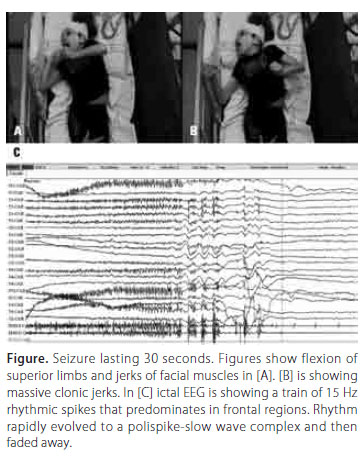LETTERS
Topiramate is effective for status epilepticus and seizure control in neuraminidase deficiency
Topiramato é efetivo no tratamento de estado de mal epiléptico e controle de crises na deficiência de neuraminidase
José Augusto BragattiI; Carolina Machado TorresI; Cristina Brinckmann Oliveira NettoII; Leonardo VedolinIII; Eliana GarzonIV; Carlos Roberto de Mello RiederI; Ida Vanessa Doederlein SchwartzII,IV; Marino Muxfeldt BianchinI
IDivision of Neurology, Hospital de Clínicas de Porto Alegre, Porto Alegre RS, Brazil
IIMedical Genetics, Hospital de Clínicas de Porto Alegre, Porto Alegre RS, Brazil
IIIDivision of Radiology, Hospital Moinhos de Vento, Porto Alegre RS, Brazil
IVUniversity of São Paulo School of Medicine, Neurology Department, São Paulo SP, Brazil
VDepartment of Genetics, Universidade Federal do Rio Grande do Sul, Porto Alegre RS, Brazil
Correspondence Correspondence: José Augusto Bragatti Rua Ramiro Barcelos 2350 / sala 2040 90035-003 Porto Alegre RS - Brasil E-mail: jabragatti@terra.com.br
Sialidosis, a rare lysosomal storage disorder is caused by a deficiency of the enzyme α-N-acetyl neuraminidase, resulting from mutations in the NEU1 gene1-5. Its main phenotypes are Sialidosis types I (milder form) and II (earlier onset)1 -5. Sialidosis type II is characterized by developmental delay, macular cherry-red spot, viscero-megaly, coarse facies, dysostosis multiplex, and myoc-lonus1-5 . We report a case of status epilepticus (SE) in a patient with Sialidosis type II which had good response to topiramate.
CASE
A 16 years -old girl was admitted to our emergency unit with SE. She was using valproate 30 mg/Kg/day, primidone 10 mg/Kg/day, and clobazam 0.20 mg/Kg/day (maximum tolerated doses). Sialidosis type II was diag-nosed nine years before, by detection of high levels of urinary sialil- oligossacharides, and deficient neuramin-idase activity in leukocytes. Myoclonic seizures started at the age of eleven, and further became refractory to pharmacological treatment. Before admission, she was presenting weekly myoclonic seizures. She had neuro-psychological delay, short stature, mild dysostosis mul-tiplex, and a cherry-red spot on retinal exam. Intra-venous midazolam was increased till 0.4 mg/kg/hour without any benefit. MRI revealed cerebellar and brain atrophy. Interictal EEG showed multifocal spikes, mainly involving bilateral parassagital regions. Seizures were easily provoked by tactile stimulus, and characterized by a extensor tonic spasm in four extremities, followed by tonic arms flexion and facial muscle contraction. These movements were followed by several massive general-ized myoclonic jerks (Figure). Ictal EEG showed a train of 15 Hz rhythmic spikes, predominantly in frontal re-gions, rapidly evolving to a polispike-slow wave complex with fast fading away, and replaced by a generalized de-pression of the background activity. Seizures occurred every 5 minutes, with total duration of 30 seconds. Val-proic acid was increased to 75 mg/Kg/day without ben-efit. Next day, we introduced topiramate 2.5 mg/Kg/day. There was improvement in seizure control, and 8 hours later patient was seizure-free. After discharge, she used this scheme for two years, with brief myoclonic jerks oc-curing in a monthly frequency.
DISCUSSION
Drugs used for treatment of SE are phenytoin, bezo-diazepines, phenobarbital, and propofol1,2, but treatment of SE in myoclonic progressive epilepsies is still not es-tablished. Midazolam was not effective here. Other op-tions were propofol or barbiturates. Phenobarbital was already in use. Propofol is useful during acute phase but is not an option for long-term seizure control. Phenytoin could aggravate the myoclonic seizures of our patient.
For the same reason, benzodiazepines would not be an option, because tonic seizures, a not uncommon type of seizure in the epileptic encephalopathies, could be originated by it. Newer agents (valproate, levetiracetam, or topiramate) might be an interesting option1 . These drugs are also useful as antiepileptic drugs after SE. Le-vetiracetam was not available to us. We tried topiramate and fortunately obtained a good response with a rela-tively low dosage. Then, we suggest topiramate for treat-ment of both, SE and seizures, in Sialidosis. Topiramate is possibly also a useful drug for other forms of progres-sive myoclonic epilepsies. Further studies are necessary to clarify these matters.
Received 24 January 2011
Received in final form 18 February 2011
Accepted 3 March 2011
Support: The authors receive financial support from FAPERGS, FIPE and CNPq. Dr. Bianchin and Dr Schwartz were further supported by CNPq (#305501/2007-0 and # 305147/2007-2, respectively).
- 1. Bleck TP. Intensive care unit management of patients with status epilep-ticus. Epilepsia 2007;48(Suppl 8):S59-S60.
- 2. Costello DJ, Cole AJ. Treatment of acute seizures and status epilepticus. J Intensive Care Med 2007;22:319-347.
- 3. Gopaul KP, Crook MA. The inborn errors of sialic acid metabolism and their laboratory investigation. Clin Lab 2006;52:155-169.
- 4. Lowden JA, O'Brien JS. Sialidosis: a review of human neuraminidase defi-ciency. Am J Hum Genet 1979;31:1-18.
- 5. Pshezhetsky AV, Richard C, Michaud L, et al. Cloning expression and chro-mosomal mapping of lysossomal sialidase and characterization of muta-tions in sialidosis. Nat Genet 1997;15:316-320.
Publication Dates
-
Publication in this collection
19 July 2012 -
Date of issue
June 2011


